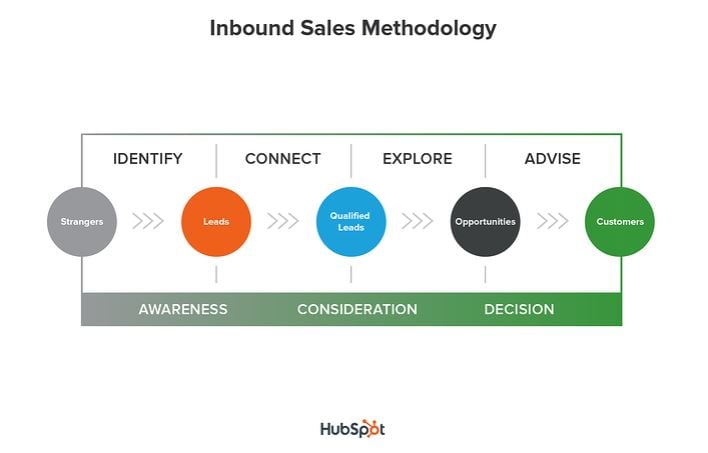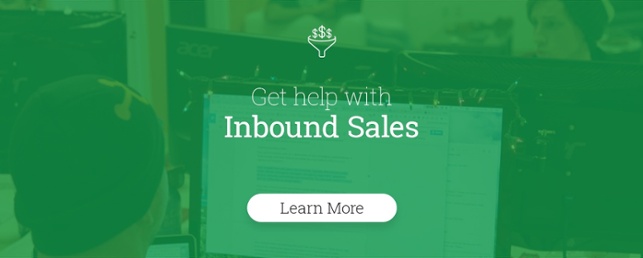We’ve all heard the mantra that the internet has changed the way we do business. Whether it’s video content to bring prospects to your brand, or it’s humans deleting cold emails, there’s no denying that it’s more difficult than ever to reach our customers.
HubSpot is the torch bearer of inbound marketing. Their work led to the launch of inbound sales. But what does that really mean? And can any business put this to work?
First, let’s look at what inbound sales means.
Inbound sales is a sales strategy and methodology that prioritizes the needs, challenges, goals and interests of individual buyers. Forget focusing on closing the sale as soon as possible. Instead, inbound sales professionals know they need to meet consumers where they are, and then guide them through the decision-making process. It’s less about push, and more about helping.
In short, inbound sales is a personalized, helpful, modern sales methodology that focuses on a prospect's pain points, develops a trusted consultant-user relationship, and turns the traditional sales process into a buyer’s journey.
Got it? Good. Now let’s look at how you can implement inbound sales in your business, on your sales team, or for yourself.

Define Your Buyer’s Journey
Unfortunately, humans are creatures of habit and finding the path of least resistance. This is true of legacy sales teams as well - they’re human after all! These teams build their sales process around their own needs, not the needs of their buyers.
Too often legacy salespeople ignore the needs of the buyer and fail to support them through the purchasing process. Instead, they tend to focus their energy on simply following a checklist and checking the boxes a sales manager laid out for them.
As a result, the seller and buyer feel misaligned. Worse yet, this self-serving process delivers minimal value to the buyer. Buyers don’t want to be treated like another number; prospected, demoed, and closed. This traditional, legacy path add zero value to the buyer. They can find all the information they would get in these meetings without a sales rep. Sales doesn’t hold that information any longer.
If sales can’t add value beyond the information buyers can find on their own, the buyer has no reason to engage with salespeople at all.
An inbound sales team turns the table, starting with understanding the buyer’s journey. Before they ever pick up a phone or send an email, they make it a priority to understand their buyer’s universe.
It helps to think of the buyer’s journey in three parts:
Awareness
Consideration
Decision
Awareness
😮 In Awareness, buyers know the challenge they’re experiencing or have a goal they want to pursue. This is where they decide whether it should be a priority.
Want to fully understand your buyer’s awareness stage? Ask these questions:
- How do our buyers describe the challenges or goals we can help with?
- Where do buyers go to learn more about these challenges or goals?
- How do buyers decide whether the challenge or goal should be prioritized?
Consideration
🤔 In Consideration, buyers have a clearly defined challenge or goal. They’ve committed to addressing it. Now they’re evaluating different strategies, tools, and methods available to solve for their needs.
You can begin to understand your buyer’s consideration stage with these questions:
- What categories of solutions do our buyers investigate?
- How do our buyers perceive the pros and cons of each category?
- What differentiates your category in the buyer’s eyes?
Decision
😀 During Decision, a buyer has decided on a solution category. Now they’re looking for a business in this category. They may create a list of specific offerings or brands, and decide on the one that best meets their needs. They could also make this decision very quickly without a list. That’s why inbound marketing is so important to this journey.
Understand your buyer’s decision stage by asking yourself these questions:
- What offerings do your buyers typically evaluate?
- How do buyers evaluate available offerings?
- What differentiates your offering in the buyer’s eyes?
- Who needs to be involved in the decision? Are there different decision makers whose perspective on the decision you need to address?
Develop a Buyer-Focused Sales Process
You want to support your buyer through their journey. Once you’ve defined that journey, your next step is to build your sales process. An inbound sales process supports the buyer through their purchasing journey rather than focusing on the sales team’s process. With this culture in place, salespeople and buyers feel much more aligned through the buying and selling process. They’re not at odds with each other.
As you begin to develop an inbound sales process, dig into what your salespeople can do at the awareness, consideration, and decision stages to support your buyers.
I’m a fan of HubSpot’s four-part framework for your sales process. They call it the Inbound Sales Methodology:
Identify
Connect
Explore
Advise
Identify
First, an inbound sales team identifies strangers who may have goals or challenges they can help with. Consider these strangers leads now that you know who they are.
Connect
Next, inbound sales teams connect with these leads. Here they help the leads decide whether they should prioritize the goal or challenge. At this point the lead becomes a qualified lead if they decide to move forward.
Explore
Third, inbound sales professionals explore their qualified leads’ goals or challenges. Here you’re assessing whether your offering is a good fit for the qualified lead and their needs. Good fit? These qualified leads become opportunities.
Advise
Finally, inbound salespeople advise opportunities on how their company’s offering is best suited to address their needs. If the buyer agrees, these opportunities become customers.
Understanding Inbound Sales Versus Outbound Sales
If inbound sales are sales that come to you, then it follows that outbound sales are sales that you went out and won on your own.
You reached out (probably more than once), spoke with a lead over the phone, through an unsolicited email message, or a cold social media outreach, and finally achieved the sale.
With outbound, you’re convincing the client on how your solution fits their needs, oftentimes even before they know they have a need. This cold outreach and convincing model often takes a long time and a lot of resources. This is an outbound sale.
Inbound sales is newer and shinier than its counterpart. But that doesn’t mean it’s the only way, or that outbound is dead. Most businesses find they need both working together to achieve maximum sales.
You can use inbound methods to support outbound efforts.
Align Your Sales Process and Your Customer Journey
If you know your different buyer personas and their journeys, you should adjust your sales process and align it to that journey as best as you can. That way, you’ll make sure that you’re providing the most personalized experience possible.
Sure, you could throw it all out and start over, but that’s not likely to happen. Bringing the two together can help you drive growth and revenue. Evolution is often better than starting over.
Using Social Selling to Connect With Leads
One inbound tool you can use with inbound sales and outbound sales is the practice of social selling. Social media platforms like LinkedIn, Facebook, Instagram and others allow your customers to connect with you more directly than ever before.
This also means salespeople can use the platforms to build relationships with potential prospects and monitor social conversations that affect your business world. Then they can join them at the right time and to present their solution. People do business with people they get to know, like and trust. Your sales team is that face of the solution you’re offering.
Get better at social selling with a few tips from Hootsuite:
- Concentrate on listening and monitoring first (to jump in at the right time)
- Present yourself in a personal but professional way
- Always provide value to your leads when you’re interacting with them
Go Forth with Inbound Sales 101
As we move into the future, and the relationship between business and buyer evolves, inbound sales shows off the true psychology of sales, marketing, and customers. The process works fluidly with many purchasing patterns and tactics worldwide.
You’re a customer. The next time you buy something, take a step back and consider the three steps of Awareness, Consideration, and Decision. How did you become aware of the fact that you need or want something? How did you consider if it’s the item you really want to buy? And how did you decide whether or not to make that final purchase?
Then put that experience to work for your sales team.
Sales deal photo by Cytonn Photography on Unsplash
Journey photo by Clemens van Lay on Unsplash






